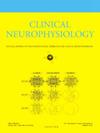Cortical hyperexcitability in corticobasal syndrome as revealed by giant somatosensory evoked potentials
IF 3.6
3区 医学
Q1 CLINICAL NEUROLOGY
引用次数: 0
Abstract
Objective
Corticobasal syndrome (CBS) is characterized by asymmetric symptoms, including myoclonus. Few studies have reported the observation of giant somatosensory evoked potentials (SEPs) in CBS patients. We aimed to clarify the origin and characteristics of myoclonus by examining the relationships among clinical symptoms and electrophysiological and brain imaging findings.
Methods
We conducted a cross-sectional study of 23 patients with CBS who underwent SEPs at Kyoto University Hospital from 2008 to 2022. We compared SEPs, cortical reflex (C-reflex), and cerebral perfusion in the precentral and postcentral gyri and thalamus between the symptom-dominant and non-dominant hemispheres.
Results
Giant SEPs were observed in 17 of 23 (74 %) patients, and C-reflexes were present in 3 of 13 (23 %) patients. Cerebral perfusion decreased significantly on the symptom dominant contralateral hemisphere.
Conclusions
The high frequency of giant SEPs than previously reported in CBS demonstrated that at least part of their myoclonus has a cortical origin, warranting further investigation into the underlying mechanisms.
Significance
The high prevalence of giant SEPs in CBS suggests a cortical contribution to their myoclonus, providing electrophysiological evidence to help better understanding and clinical assessment of the disorder.
巨大体感诱发电位揭示皮质基底综合征的皮质高兴奋性
目的皮质基底综合征(CBS)以不对称症状为特征,包括肌阵挛。在CBS患者中观察到巨大体感诱发电位(SEPs)的研究很少。我们的目的是通过检查临床症状与电生理和脑成像结果之间的关系来阐明肌阵挛的起源和特征。方法:我们对2008年至2022年在京都大学医院接受sep治疗的23例CBS患者进行了横断面研究。我们比较了症状显性和非显性大脑半球的sep、皮质反射(c反射)和中央前、中央后脑回和丘脑的脑灌注。结果23例患者中有17例(74%)出现巨大sep, 13例患者中有3例(23%)出现c反射。对侧半球脑灌注明显减少。结论:与先前报道的CBS病例相比,巨大sep的发生率较高,这表明至少部分肌鞘性肥大起源于皮层,值得进一步研究其潜在机制。CBS中巨sep的高患病率提示皮质对其肌阵挛的贡献,为更好地理解和临床评估该疾病提供了电生理证据。
本文章由计算机程序翻译,如有差异,请以英文原文为准。
求助全文
约1分钟内获得全文
求助全文
来源期刊

Clinical Neurophysiology
医学-临床神经学
CiteScore
8.70
自引率
6.40%
发文量
932
审稿时长
59 days
期刊介绍:
As of January 1999, The journal Electroencephalography and Clinical Neurophysiology, and its two sections Electromyography and Motor Control and Evoked Potentials have amalgamated to become this journal - Clinical Neurophysiology.
Clinical Neurophysiology is the official journal of the International Federation of Clinical Neurophysiology, the Brazilian Society of Clinical Neurophysiology, the Czech Society of Clinical Neurophysiology, the Italian Clinical Neurophysiology Society and the International Society of Intraoperative Neurophysiology.The journal is dedicated to fostering research and disseminating information on all aspects of both normal and abnormal functioning of the nervous system. The key aim of the publication is to disseminate scholarly reports on the pathophysiology underlying diseases of the central and peripheral nervous system of human patients. Clinical trials that use neurophysiological measures to document change are encouraged, as are manuscripts reporting data on integrated neuroimaging of central nervous function including, but not limited to, functional MRI, MEG, EEG, PET and other neuroimaging modalities.
 求助内容:
求助内容: 应助结果提醒方式:
应助结果提醒方式:


